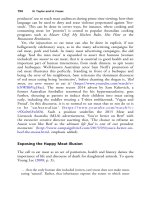The palgrave international handbook of a 481
Bạn đang xem bản rút gọn của tài liệu. Xem và tải ngay bản đầy đủ của tài liệu tại đây (37.93 KB, 1 trang )
Animals in War
483
p. 108). Again, this is merely one example of a much broader reality, one
utterly replete with suffering and abuse.
As I argue in Animals and war, we tend to imagine the World Wars in
terms of increasingly sophisticated machinery such as airplanes, tanks,
machine guns, and so on. However, animals, and especially horses, were
also crucial to the war effort—ironically, often precisely because of the use of
other machinery (2013, p. 10). Keegan describes this scenario compellingly,
noting that the planning efforts in Europe during war mobilization in 1914
hinged on the presence and function of rail:
Once arrived, however, they found that the almost miraculous mobility
conferred by rail movement evaporated. Face to face with each other, they
were no better able to move or transport their supplies than Roman legions
had been; forward of railhead, soldiers had to march, and the only means of
provisioning them was by horse-drawn vehicles. Indeed, their lot was worse
than that of the well-organized armies of former times, since contemporary
artillery created a fire-zone several miles deep within which re-supply by horse
was impossible. . . . (1993, pp. 307–308)
This problem was further intensified by the fact that modern war
demanded an ever larger trans-shipment of munitions between railhead and
guns, which could only be undertaken by horses. As a result, horse fodder
became the single largest category of cargo unloaded, for example, at French
ports for the British arm on the Western Front throughout the period 1914–18
(1993, p. 308).
This scenario also meant great competition among nations in obtaining
horses. Kistler reports that ‘Germany began World War I with 4.5 million
horses, [. . . . ] far more than any other nation except Russia’ (2011, p. 192).
To make up their deficit, the Allies relied significantly on the American
supply, but horses gathered in such numbers were nonetheless sorely
neglected. DiMarco quotes a source that notes, for instance, that by
October 1914 among the French, ‘the best commands had lost 2/3 of their
horses, of which half were lost from overriding’ (2008, p. 327). The British
regime of care also led horses to suffer:
Of 256,000 horses lost by the British on the Western Front, only 58,000 died
from enemy fire. Most died of the winter cold. Their provisions were so scarce
that many horses died from eating their own blankets, choking to death on the
buckles (Kistler 2011, p. 192).









